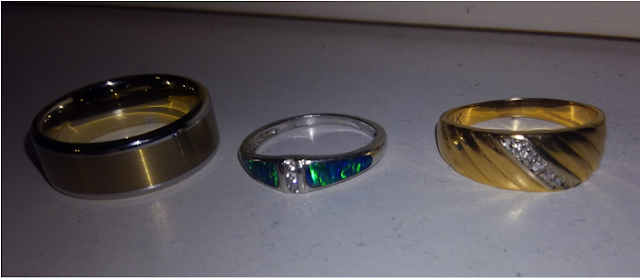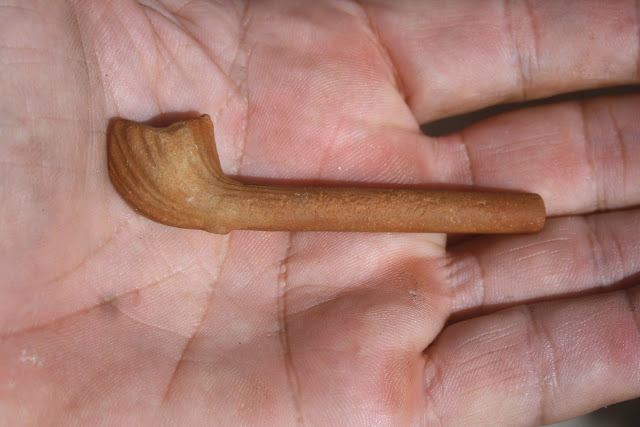Written by the TreasureGuide for the exclusive use of treasurebeachesreport.blogspot.com.
 |
Three Rings in Three Days
Finds and photo by DB
|
Congratulations and thanks DB.
---
I don't think I've detected at all this February. If I did it was very little. I always liked eye-balling and took a little walk along the banks of the Indian River yesterday. I probably walked a hundred yards or so, but was amazed to find the worn remains of a broken clay pipe. Even though it is broken, it is a wonder that it survived in as good condition as it did for all those years.
 |
| Broken Clay Pipe Find. |
Archaeologists sometimes attempt to use the diameter of the hole to get a date for a clay pipe, but that doesn't always work well unless you have a number of them, then you might be able to date a site by using the average hole diameter. The hole in this pipe measures 3/16.
I've seen a lot of old things around there, including fossils dating back thousands or millions of years old and some really old indigenous pot shards but this was a surprise. There was also plenty of modern junk laying around too.
The world is covered with evidence of the past. It is everywhere. And more is being made everyday.
Here is a paragraph from a great web site about clay pipes ( See link below.).
In the archaeological studies carried out on clay pipes (and believe me there are many!) mathematical formula's have been applied to explore the possibilities of dating them by the size of the hole in the stem. While these have been proved to work fairly well where large groups (usually dozens-hundreds) have been found it is not always possible to date a random piece of broken stem by the size of the hole because there are many other factors that come into play. The thickness of the stem, surface finish and porosity, alignment of sides, tool marks, junction at base of the bowl etc. are just some of these. However, the larger thick more weathered pipe stems that are often found with a bigger hole in the middle tend to be earlier from the 17th-18th Centuries, whereas thinner stems with even sides, smoother surfaces and much smaller holes tend to be from the 19th Century. It is worth mentioning also here that Dutch pipes of the 18th Century have very long narrow stems with smaller holes whereas English pipes of the same period tend to have larger holes so this is another thing to be considered according to where finds are made. During the Victorian period some pipes were made in such a hurry and without thought for the smoker that the hole in the stem was not always practical or even joined with the bowl.
http://www.dawnmist.org/gallery.htm
 |
| Pipe Stem. |
A web site by the National Parks Service gave the following hole sizes for English colonial sites of various time periods.
If you are wondering how to measure such things with any degree of precision, I used these bead calipers. They are useful for measuring gem sizes or anything small and are inexpensive.
 |
| Bead Calipers. |
Below is the link for the National Park Service web site about dating sites.
---
I'm still working on a post with recommendations for archaeology. I hope to have it ready soon. It is taking a little time and I've had a lot of other things to post.
Between 7 PM last night and 8 AM this morning, this blog had over three thousand page views, many from foreign countries, with France in the lead.
---
The Treasure Coast beaches have been a holding pattern for a few weeks, and there is not immediate change in site. Hurricane season will be coming around again before you know it.
I plan to post some on a Florida treasure ship claimed by France someday soon.
Happy hunting,
TreasureGuide@comcast.net
